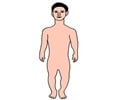Researchers have found that a novel enzyme may play a significant role in anencephaly, a rare fatal birth defect in which the brain fails to develop.
Researchers at the University of Illinois at Chicago College of Medicine have found that a novel enzyme may play a significant role in anencephaly, a rare fatal birth defect in which the brain fails to develop.
Although anencephaly can sometimes be diagnosed through ultrasound, which picks up the malformation of the head, there is no genetic test, and its cause is unknown.However, the new findings offer hope for a genetic test or even therapy for anencephaly.
By breeding special "knockout" mice that were missing the gene for the enzyme called HSD17b7, the researchers found that such mice died on the tenth day of gestation with the severe lack of brain development that characterizes the human birth defect.
Geula Gibori, UIC distinguished professor of physiology and biophysics and principal investigator of the study, said that the failure of the mice to develop, as well as the extreme nature of the changes in the formation of the animals, was very surprising.
Mice that lack enzymes of similar function are born with subtle changes in their cognitive ability, but they survive.
The researchers had previously discovered this novel enzyme and were focused on its role in converting the weak hormone estrogen into the more potent estradiol in the ovaries and its possible role in breast cancer.
Advertisement
But because the foetus receives cholesterol from the mother during gestation, the researchers did not expect the enzyme to be of much importance to development.
Advertisement
The brain becomes dependent on the biosynthesis of its own cholesterol once this blood-brain barrier forms, at day 10 of gestation.
The researchers established that in the foetus, the brain is the most important site for HSD17b7 expression and provided evidence that anencephaly may result from the loss of this enzyme.
The study appears in the October issue of the journal of Molecular Endocrinology.
Source-ANI
SRM












